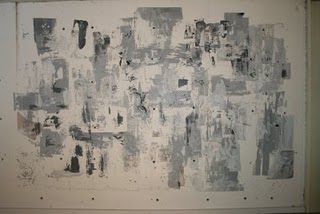John Hurrell – 2 July, 2009
Last week six 3rd year BVA candidates presented an excellent sampling exhibition of their respective interests.
Auckland
Caitlyn Porteous, Emma Fraser, Emma Macfarlane, Lyn Guinibert, Natasha Pearl, Thomas Stewart
Bypassed territory
25 - 27 June 2009
This, the third exhibiting space of St. Paul St, just round the corner from the other two less raw, international venues, is getting more usage now from AUT’s senior students - though only for short bursts. Last week six 3rd year BVA candidates presented an excellent sampling exhibition of their respective interests - six very different individuals showing floor sculpture, photographs, a wall drawing, wall sculptures of folded prints and one screened wall painting.
Emma Fraser’s large wall painting Noise had overtones of Rauschenberg’s ink-transfer and silk-screened works. Her array of screened on overlapping blotches, squiggles and smudged stains, that then had added fine ink lines delineating chosen contours, dominated a large wall with its delicate greys and scrubbed browns. This small mural alluded to decay and attrition and not narratives with recognisable images, and was by far the largest two-dimensional work in the gallery.
Lyn Guinibert’s cluster of latex-stiffened beach towels and tablecloths on the floor was intriguing for each unit was like an unopened umbrella, the fabric being left to harden while draped over the tip of a pole. Inert when single and isolated, they became active as a group, suggesting strange angular birds or shattered geological forms. This very simple idea seemed rich in explorative possibilities. It will be interesting to see where Guinibert takes it.
Printmaking methodology and folded paper sculpture were blended together by Emma Macfarlane. One work had the partially cut out but now folded, box element still attached to the original large sheet along its bottom edge, so that the two were still one work on the wall - a less sophisticated version of the eighties snipped-and-folded whiteware sculpture by British artist Bill Woodrow. The other was a grid of 9 x 7 paper boxes with an identically embossed formation on each frontal plane. The grid was a little dull; repetition for its own sake without a knowing tension. The con-joined sheet/folded form variation had more resonances.
Natasha Pearl’s photographs used expired film as strategy, aspiring to remind ‘us of a practice once dependent on scientific process and light sensitive paper.’ There was a pathos about her conscious embracing of raggedy imperfection, with images out of focus, having odd depths of field, inconstant light levels and sudden horizontal changes of hue. Without going too far the other way and lashing out at current digital ‘slickness’, these images of bush paths cleverly mixed the ‘formlessness’ of dense vegetation with a methodology that examines decay. They didn’t seem to be about nostalgia, more a wry acceptance of the history of the camera.
This gallery space seems to have been tidied up considerably since I last visited, and it has some unusual features like raw concrete columns that give it personality. Caitlyn Porteous did a wall drawing that wrapped its patterned web around a corner. Her silver-lined drawing of linked hexagonal and triangular shapes worked well overall but it could just as effectively have been on any flat wall, or better still modified for a column. As a flowing crystalline bed it didn’t have an architectural dialogue with its own site; no morphological nuance with its right-angled cross-section.
Thomas Stewart’s two works interacted in the architecture as foils. One was an installation that cleverly used the internal space by creating the skeletal framework of a room, and the other was a self-reflexive sculpture that used the space outside the gallery in the street to depict its own internal image to passers by. Stewart’s installation had a flat undulating plaster square on the floor that reflected similar oblong slabs stacked in a vertical wooden box in the wall frame. The simple box form was repeated in the second work with a larger version covering a corner window and facing out into the street. From outside the contents were revealed through the glass as a mini wall holding a mini box. It depicted itself.
Hopefully AUT will do more shows like this with senior students - and perhaps have an ongoing dialogue with Elam’s George Fraser Gallery, with longer exhibiting periods. The quality of the room is very apparent now, the location very accessible. It just needs a consistently maintained programme.
John Hurrell
Many thanks to the artists for their images. From top to bottom, the works are by Fraser, Guinibert, Macfarlane, Pearl, Porteous and Stewart.






 Advertising in this column
Advertising in this column Two Rooms presents a program of residencies and projects
Two Rooms presents a program of residencies and projects



This Discussion has 0 comments.
Comment
Participate
Register to Participate.
Sign in
Sign in to an existing account.